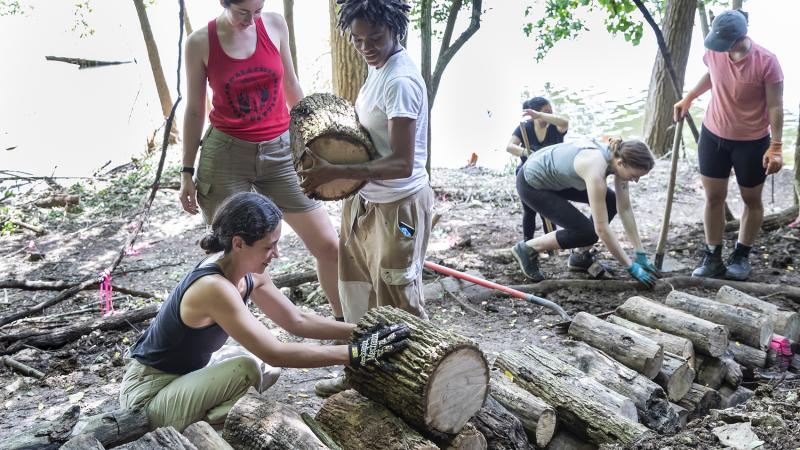The Diggers Studio: Landscape, Labor, and Representation
Down a wooded path a short distance from the McKnight Outdoor Education Center in Columbus, Knowlton School Landscape Architecture students are busy clearing a trail section of invasive honeysuckle and building steps that lead to a constructed hybrid retaining wall/seating area. The humid heat is heavy by afternoon but doesn’t dampen the will of the students rolling a boulder into place as a cornerstone for an elevated path section that will offer a shaded overlook of Griggs Reservoir.

The goal of The Diggers Studio, led by Assistant Professor of Landscape Architecture Michelle Franco, is to position physical labor and embodied knowledge as critical means to develop a socially and ecologically conscious landscape practice. In the grip of experiential education and the aim to cultivate value for the contributions of landscape laborers, students in the studio dig, saw, shovel, hoe, and plant in order to bring their collective trail design into being.
To prepare for the design, construction, and cultivation work along Griggs Reservoir, the students participated in three service-learning modules where they worked alongside wage laborers in landscape maintenance, urban agriculture, and ecological restoration. The Diggers Studio was also awarded an Ohio State Energy Partners sustainability grant for its emphasis on linking social to environmental sustainability, and for the studio’s active community partnerships—this term partnering with Columbus Recreation and Parks, Franklinton Farms, and The Nature Conservancy Ohio.
“The idea was to introduce the students to working outside in different types of landscapes and different forms of labor in order to build up their embodied knowledge of that labor before heading into the design work,” said Franco. “These experiences would give them an understanding of what it would take to build something before designing it. The service-learning modules were also designed to allow for an empathetic inhabitation of the social difference that currently exists between designers and laborers.”

Prior to developing initial design plans in the studio, the students conducted a survey of the site. “We picked a pillar that holds buoys for a no-boat zone in the reservoir to be our known base point,” explained Spencer See, a second-year graduate student. “We established a zero line that served as a reference for the entire site and from which we would base our other measurements. We then used concrete stakes around site to create a grid structure.”
A collective design was reached through consensus, but it adapted and transformed as the students engaged in the physical work. “Throughout the course, we had many opportunities for organic decision-making to happen on the site and to experience reaching consensus in various ways” said graduate student Elsie Almodovar-Reyes.
“How we are structuring the stairs was a change in the design that was formulated while working on the site,” said See. “The extent of the honeysuckle removal and grading decisions were on-site decisions. Our drainage plan is definitely unfolding as we encounter the lay of the land, so there have been some technical considerations that have been occurring in the field.”

“An aspect that has been a radical departure from typical design work has been working in consensus,” said Jack Ryan, a second-year graduate student. “It’s about developing an idea with everybody’s input and suggestions.” The students recognized individualistic tendencies common in design production, and consciously worked to reconstruct their design-thinking as participation in a collective effort.
“A typical studio does not operate in this way,” added Almodovar-Reyes. “It is a difficult and time-consuming process but one that offers more room for collaboration. Each person in the group brings a set of skills and experiences to contribute to the designing and building process.”
Students also shared leadership roles, with revolving student crew leaders directing the work each week. “This experience in collective organization and consensus decision-making empowers the students to develop landscape projects within their own communities, outside of traditional models of practice,” said Franco.
The labor of landscape work that the students participated in and witnessed during their service-learning modules offered a unique opportunity to develop drawing strategies that represent the skill and embodied knowledge of landscape laborers. “Responsible representation should celebrate the work and people that build the world around us,” said third-year graduate student Ryan Vorndran. “We have been doing two spreads per week of sketches of what we have seen during our work as well as experimenting with illustrative ways to document labor,” added Jack Ryan, about developing this drawing practice as a form of inclusion.

The final stage of the studio’s work on the site was determining the planting concept and subsequently sourcing, transporting, and planting the plants. The species allowed for introduction at the site were stipulated by the City of Columbus Land Stewardship Program, and for this site on Griggs Reservoir included only woodland species native to Central Ohio. Selected plants, sourced from Scioto Gardens Nursery, included a tulip tree (Liriodendron tulipifera), oak sedge (Carex pennsylvanica), buttonbush (Cephelanthus occidentalis), boneset (Eupatorium perfoliatum), wild geranium (Geranium maculatum), doll’s eyes (Actaea pachypoda), redbud (Cercis canadensis), and silky dogwood (Cornus amomum).
At the conclusion of the academic session, the group invited friends and colleagues to the site to share their studio’s efforts to foster ecological and social sustainability through direct engagement with landscape labor and laborers. The group considered the site itself as a “final deliverable,” and additionally created a set of drawings that described technical aspects of the work as well as the experiential qualities of it—the lived labor.

"This studio exposed me to a different side of landscape architecture as it taught me what a design could be outside of the computer,” said junior undergraduate student Faty Diallo, reflecting on her experience in the field. “I learned the value of physical labor and its toll on the body. I came out of it with a different level of appreciation for design, landscapes, and especially the workers within them."


